Solar eclipse of May 20, 1966
An annular solar eclipse occurred on May 20, 1966. A solar eclipse occurs when the Moon passes between Earth and the Sun, thereby totally or partly obscuring the image of the Sun for a viewer on Earth. An annular solar eclipse occurs when the Moon's apparent diameter is smaller than the Sun's, blocking most of the Sun's light and causing the Sun to look like an annulus (ring). An annular eclipse appears as a partial eclipse over a region of the Earth thousands of kilometres wide. Annularity was visible from Guinea (including the capital city Conakry), Mali, Algeria, Libya, Greece, Turkey, the Soviet Union (today's Russia and Kazakhstan) and China. The Sun's altitude was 70°.
| Solar eclipse of May 20, 1966 | |
|---|---|
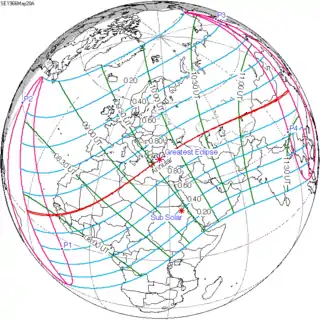 Map | |
| Type of eclipse | |
| Nature | Annular |
| Gamma | 0.3467 |
| Magnitude | 0.9991 |
| Maximum eclipse | |
| Duration | 5 sec (0 m 5 s) |
| Coordinates | 39.2°N 26.4°E |
| Max. width of band | 3 km (1.9 mi) |
| Times (UTC) | |
| Greatest eclipse | 9:39:02 |
| References | |
| Saros | 137 (33 of 70) |
| Catalog # (SE5000) | 9434 |
Related eclipses
Solar eclipses of 1964–1967
This eclipse is a member of a 1964–1967 series at alternating nodes every 6 synodic months.
Note: Partial solar eclipses on January 14, 1964 and July 9, 1964 belong to the previous lunar year set.
| Solar eclipse series sets from 1964–1967 | ||||||
|---|---|---|---|---|---|---|
| Ascending node | Descending node | |||||
| Saros | Map | Gamma | Saros | Map | Gamma | |
| 117 |  1964 June 10 Partial | -1.13926 | 122 |  1964 December 4 Partial | 1.11929 | |
| 127 | 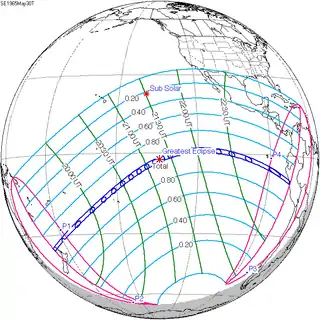 1965 May 30 Total | -0.42251 | 132 |  1965 November 23 Annular | 0.39061 | |
| 137 |  1966 May 20 Annular | 0.34672 | 142 |  1966 November 12 Total | -0.33001 | |
| 147 | 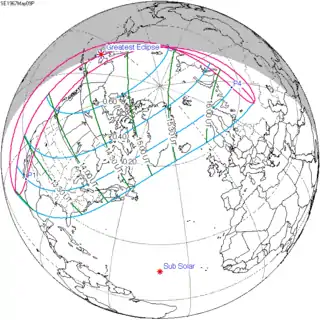 1967 May 9 Partial | 1.14218 | 152 |  1967 November 2 Total (non-central) | -1.00067 | |
Saros 137
It is a part of Saros cycle 137, repeating every 18 years, 11 days, containing 70 events. The series started with partial solar eclipse on May 25, 1389. It contains total eclipses from August 20, 1533 through December 6, 1695, first set of hybrid eclipses from December 17, 1713 through February 11, 1804, first set of annular eclipses from February 21, 1822 through March 25, 1876, second set of hybrid eclipses from April 6, 1894 through April 28, 1930, and second set of annular eclipses from May 9, 1948 through April 13, 2507. The series ends at member 70 as a partial eclipse on June 28, 2633. The longest duration of totality was 2 minutes, 55 seconds on September 10, 1569. Solar Saros 137 has 55 umbral eclipses from August 20, 1533 through April 13, 2507 (973.62 years).
| Series members 30–40 occur between 1901 and 2100: | ||
|---|---|---|
| 30 | 31 | 32 |
 April 17, 1912 |
 April 28, 1930 |
 May 9, 1948 |
| 33 | 34 | 35 |
 May 20, 1966 |
 May 30, 1984 |
 June 10, 2002 |
| 36 | 37 | 38 |
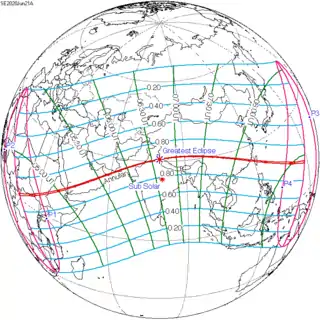 June 21, 2020 |
 July 2, 2038 |
 July 12, 2056 |
| 39 | 40 | |
 July 24, 2074 |
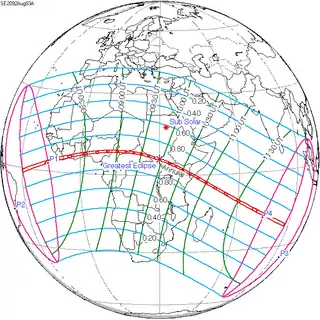 August 3, 2092 | |
Metonic series
The metonic series repeats eclipses every 19 years (6939.69 days), lasting about 5 cycles. Eclipses occur in nearly the same calendar date. In addition, the octon subseries repeats 1/5 of that or every 3.8 years (1387.94 days). All eclipses in this table occur at the Moon's ascending node.
| 22 eclipse events between December 24, 1916 and July 31, 2000 | ||||
|---|---|---|---|---|
| December 24–25 | October 12–13 | July 31-Aug 1 | May 18–20 | March 7–8 |
| 91 | 93 | 95 | 97 | 99 |
| December 23, 1878 | October 12, 1882 | July 31, 1886 | May 18, 1890 | March 7, 1894 |
| 101 | 103 | 105 | 107 | 109 |
| December 23, 1897 | October 12, 1901 | August 1, 1905 | May 19, 1909 | March 8, 1913 |
| 111 | 113 | 115 | 117 | 119 |
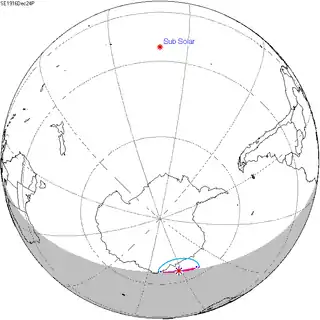 December 24, 1916 |
October 12, 1920 |  July 31, 1924 |
 May 19, 1928 |
 March 7, 1932 |
| 121 | 123 | 125 | 127 | 129 |
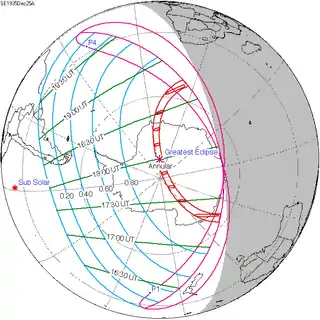 December 25, 1935 |
 October 12, 1939 |
 August 1, 1943 |
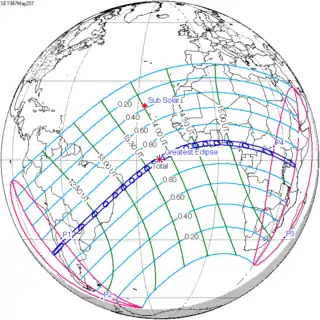 May 20, 1947 |
 March 7, 1951 |
| 131 | 133 | 135 | 137 | 139 |
 December 25, 1954 |
 October 12, 1958 |
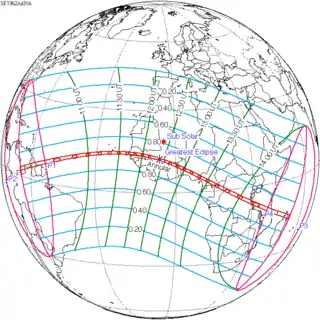 July 31, 1962 |
 May 20, 1966 |
 March 7, 1970 |
| 141 | 143 | 145 | 147 | 149 |
 December 24, 1973 |
 October 12, 1977 |
 July 31, 1981 |
 May 19, 1985 |
 March 7, 1989 |
| 151 | 153 | 155 | 157 | 159 |
 December 24, 1992 |
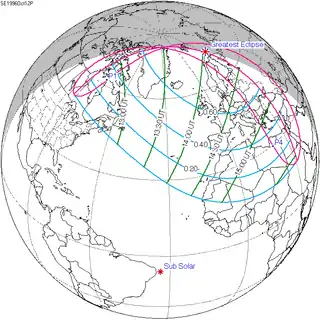 October 12, 1996 |
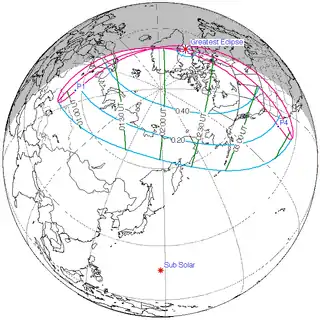 July 31, 2000 |
May 19, 2004 | March 7, 2008 |
| 161 | 163 | 165 | 167 | 169 |
| December 24, 2011 | October 13, 2015 | August 1, 2019 | May 19, 2023 | March 8, 2027 |
Notes
References
- Earth visibility chart and eclipse statistics Eclipse Predictions by Fred Espenak, NASA/GSFC
.jpg.webp)

